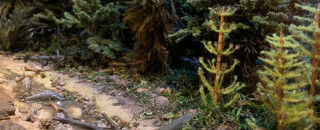Polar DinoFest: Anne-Laure Decombeix
By Riley Black
Antarctica isn't exactly the sort of place that brings up images of warm, lush forests. The southern continent is practically synonymous with rock and ice. And yet, over 200 million years ago, impressive forests grew on land now preserved in Antarctica. The stories these fossils tell are among the research interests of Paris-based Centre National de la Recherche Scientifique (CNRS) paleobotanist Anne-Laure Decombeix.
Studying fossil plants isn't easy. Part of that's because fossils often record only one part of a plant rather than the entire organism. "There are plants, for example, for which we only know the leaves and we have no idea if they were borne on trees or smaller plants," Decombeix says. Rare finds of fossil plants showing multiple parts are often needed to link the pieces together.
Even so, Decombeix notes, having any part of a fossil plant can yield a great deal of information about the past. A fossil tree trunk, for example, can help paleontologists understand how big a fossil plant was. Traces of branches, as well, can outline the shape of the tree. Microscopic details of the wood can help place the tree with its close relatives. Signs of other organisms - such as fungi or insects - tell us something about the role the tree played in its forest. "Every different organ has a story to tell and can provide information on the plant and its environment," Decombeix says.
Drawing from such clues, Decombeix and colleagues have been able to envision what Antartcia was like during the Triassic Period, between 250 and 200 million years ago.
"Walking in a Triassic forest in Antarctica would probably feel quite strange," Decombeix says. There were no flowering plants and no grasses. Instead, you'd see some plants that might look odd to our modern eyes. Many trees in these ancient forests belonged to a group called corystosperms. "They were relatively large trees with leaves that looked a bit like fern leaves," Decombeix says. Alongside those grew some conifers and ginkgos, types of tree that still grow in forests around the world today. And beneath those towering plants grew an understory of ferns, horsetails, and cycads, creating a different kind of forest community than today.
Aside from setting the scene for the animals that lived in Triassic Antarctica, some of the plants tell us something about what life was like back then. "The study of growth rings in tree trunks show that these plants were growing relatively well in the polar regions," Decombeix says, with slowed growth during the fall. That's probably because of the shortened days near the pole, recorded in the growth of fossil plants. "What is very unique," Decombeix says, "is to imagine these diverse and complex forests standing in the complete darkness for months during the polar night."
Click Here to Explore More of NHMU's Polar DinoFest
Riley Black is the author of Skeleton Keys, My Beloved Brontosaurus, Prehistoric Predators, and a science writer for the Natural History Museum of Utah, a part of the University of Utah in Salt Lake City. Our mission is to illuminate the natural world and the place of humans within it. In addition to housing outstanding exhibits for the public, NHMU is a research museum. Learn more.



